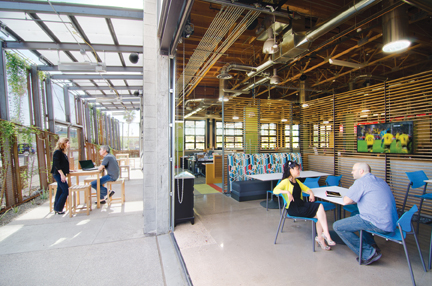As a company, DPR Construction has a deep-seated commitment to sustainability, its employees, and the communities it serves. A couple of years ago, when the lease for its Phoenix office came up, the firm seized the opportunity to create an ultra-green environment for its 101-person Phoenix office and field staff.
Working with A/E firm SmithGroupJJR, DPR converted a vacant 16,533-sf one-time “adult-themed boutique” in the city’s reemerging Discovery Triangle into a LEED-NC Platinum office, one that is on target to be the first net-zero commercial office building in Arizona.
The Building Team—including sustainability consultant DNV KEMA and consulting structural engineer PK Associates—forged numerous paths to energy reduction. They used an 87-foot zinc-clad solar chimney to create a convection current that draws air into the building through four evaporative cooling “shower towers” equipped with internal misters and showerheads. The pre-cooled air then flows through the open office space, and hot air exhausts back through the chimney.
PROJECT SUMMARY
DPR CONSTRUCTION, PHOENIX REGIONAL OFFICE
Phoenix, Ariz.Building Team
Submitting firm: SmithGroupJJR (architect/MEP engineer), in conjunction with DPR Construction (owner/developer/GC)
Structural engineer: PK Associates Consulting Structural Engineers
Sustainability consultant: DNV KEMA Energy & SustainabilityGeneral Information
Size: 16,533 sf
Construction cost: $3,762,000
Construction time: February 2011 to October 2011
Delivery method: Design-build
Twelve eight-foot-diameter fans, three oversized roll-up doors, and 87 operable windows installed along the east and north façades further support the building’s passive cooling system. Eighty-two solar optical tubes bring additional daylight into the workspace, helping to cut artificial lighting by 70%.
LEDs provide exterior site lighting, but the team decided against using LEDs on the interior because they did not meet the project goal of a maximum 10-year return on investment. A phantom-load reduction “vampire” switch cuts off 90% of plug loads at night.
The tally: Net energy use intensity was cut to 28.85 kBtu/sf/year; lighting power density was reduced to 0.96 watts/sf. Net-zero energy was achieved through the installation of a 79.6 kW PV-covered canopy over half the parking lot.
To further its commitment to the community, DPR has opened its building to host meetings for local business groups, students, and nonprofit organizations. +
Related Stories
MFPRO+ New Projects | Oct 30, 2024
BIG’s One High Line finally reaches completion in New York City’s West Chelsea neighborhood
One High Line, a luxury residential project spanning a full city block in New York’s West Chelsea neighborhood, reached completion this summer following years of delays related to investor lawsuits.
Urban Planning | Oct 30, 2024
Bridging the gap: How early architect involvement can revolutionize a city’s capital improvement plans
Capital Improvement Plans (CIPs) typically span three to five years and outline future city projects and their costs. While they set the stage, the design and construction of these projects often extend beyond the CIP window, leading to a disconnect between the initial budget and evolving project scope. This can result in financial shortfalls, forcing cities to cut back on critical project features.
MFPRO+ New Projects | Oct 30, 2024
Luxury waterfront tower in Brooklyn features East River and Manhattan skyline views
Leasing recently began for The Dupont, a 41-story luxury rental property along the Brooklyn, N.Y., waterfront. Located within the 22-acre Greenpoint Landing, where it overlooks the newly constructed Newtown Barge Park, the high-rise features East River and Manhattan skyline views along with 20,000 sf of indoor and outdoor communal space.
Libraries | Oct 30, 2024
Reasons to reinvent the Midcentury academic library
DLR Group's Interior Design Leader Gretchen Holy, Assoc. IIDA, shares the idea that a designer's responsibility to embrace a library’s history, respect its past, and create an environment that will serve student populations for the next 100 years.
Resiliency | Oct 29, 2024
Climate change degrades buildings slowly but steadily
While natural disasters such as hurricanes and wildfires can destroy buildings in minutes, other factors exacerbated by climate change degrade buildings more slowly but still cause costly damage.
Office Buildings | Oct 29, 2024
Editorial call for Office Building project case studies
BD+C editors are looking to feature a roundup of office building projects for 2024, including office-to-residential conversions. Deadline for submission: December 6, 2024.
Healthcare Facilities | Oct 28, 2024
New surgical tower is largest addition to UNC Health campus in Chapel Hill
Construction on UNC Health’s North Carolina Surgical Hospital, the largest addition to the Chapel Hill campus since it was built in 1952, was recently completed. The seven-story, 375,000-sf structure houses 26 operating rooms, four of which are hybrid size to accommodate additional equipment and technology for newly developed procedures.
Multifamily Housing | Oct 28, 2024
A case for mid-rise: How multifamily housing can reshape our cities
Often referred to as “five-over-ones,” the mid-rise apartment type is typically comprised of five stories of apartments on top of a concrete “podium” of ground-floor retail. The main criticism of the “five-over-one” is that they are often too predictable.
Sports and Recreational Facilities | Oct 24, 2024
Stadium renovation plans unveiled for Boston’s National Women’s Soccer League
A city-owned 75-year-old stadium in Boston’s historic Franklin Park will be renovated for a new National Women’s Soccer League team. The park, designed by Fredrick Law Olmsted in the 1880s, is the home of White Stadium, which was built in 1949 and has since fallen into disrepair.
Laboratories | Oct 23, 2024
From sterile to stimulating: The rise of community-centric life sciences campuses
To distinguish their life sciences campuses, developers are partnering with architectural and design firms to reimagine life sciences facilities as vibrant, welcoming destinations. By emphasizing four key elements—wellness, collaboration, biophilic design, and community integration—they are setting their properties apart.

















